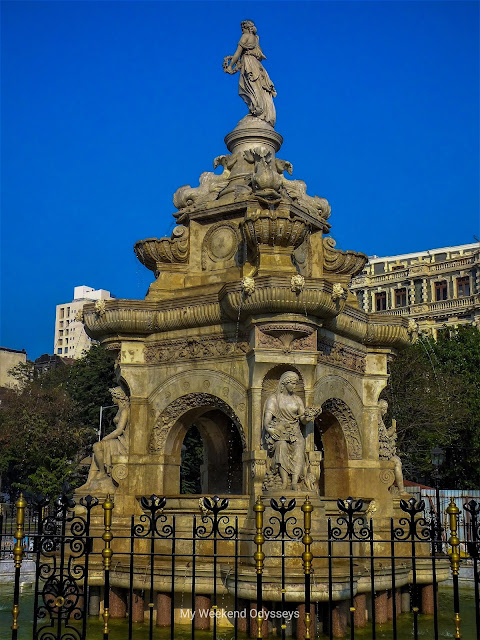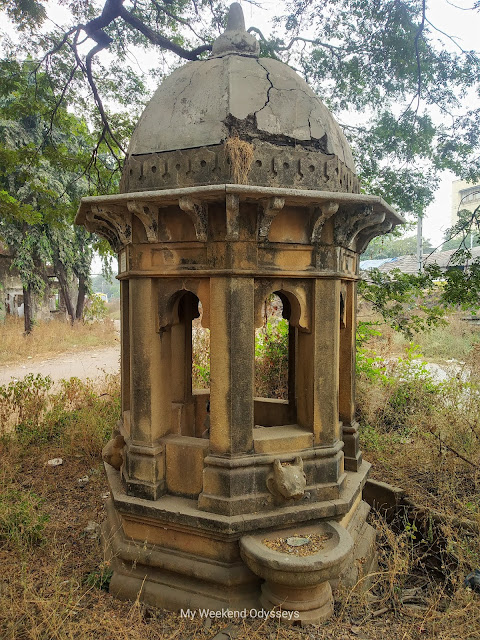The tales of Fountains and Pyaavs - Walking the Pyaav circuit
When we talk about the fountains of Mumbai, The first picture that comes to our mind is a very ornate and beautiful fountain called "Flora Fountain" named after the Greek Goddess of flower and spring "Flora" located at what was once the heart of Bombay. Digging deeper into its history, It was interesting to know that the architectural beauty was meant to be for Victoria Gardens but was placed at the exact location of one of the three gates of Bombay fort when it was demolished in 1860. This was an ornamental fountain, but we also have fountains and pyaav built across Mumbai in the 19th century by philanthropists, civic bodies, etc which was a humanitarian response to the water needs of the working and labor class. There were fountains which were very simple structures while some were architectural beauty which also vitalized the public space. The important aspect is the location of the pyaavs which were strategically built along with the old tram network or major market places where there was a movement of day to day travelers or working people. Also seen are few fountains which also had a trough for animals which could also quench their thirst as horse carts and bullock carts were once a major mode of transport.
With the advent of the 20th century and with the supply of water to households by municipal bodies, as well as with lack of hygiene, fear of contamination, and the floating of "Germ theory", These fountains and pyaavs soon lost their relevance, fell into disuse and went into neglect, unfortunately. But in recent years with the advent of the conservation movement, there has been a lot of effort and resources plugged in to document, restore and bring these once heritage of Mumbai back to life. There are close to 100 fountains and pyavs which have been documented and spread across the city of Mumbai. While exploring different precincts in South Bombay or other heritage areas and monuments, I have come across a few of these monuments and have also captured them through my lens. Though there are many detailed blogs, articles available online, and even a published book that provides in-depth details about these monuments, Here are some of these monuments which I have visited and captured through my lens.
Flora Fountain - located at Hutatma chowk was built in 1864 and it's one of the most famous and beautiful monuments and a landmark in heart of Mumbai. It stands at the original gate of the walled Fort of Bombay which was demolished in 1860. Named after the Greek Goddess Flora, it was erected in memory of Sir Bartle Frere who was governor of Mumbai. Carved in imported Portland stone, decorative arches, Greek goddess statues, and female figures at the apex are some notable features of this monument.
Bai Mancooverbai Ranadas fountain outside Horniman circle garden: The heritage associated with this location is second to none, Built-in 1873, This fountain was built on top of a well which was used in the initial days of Bombay Green when it was a place where cotton and opium was traded. It is also the same place where the foundation of the Bombay Stock Exchange was laid. Even today the well underneath is the source of water for this fountain as well as for the Horniman circle garden.
St Thomas Cathedral fountain: This unique Gothic-styled fountain was built in England and shipped to Bombay. It was built in 1864 and was donated by Sir Cawasji Jehangir Readymoney who used to stay in a building located close to the Cathedral. It is also unique in the way that Parsi gentlemen donating a fountain for a church.
Shivaji Park fountain: It's a simple structure made out of donations received through the Attorney general in memory of the late Ramji Setiba. It is located on the footpath near a temple.
Maheshwari Udyan (Matunga East) - Seth Ramji Keshawji contractor pyaav - Built with white marble stone in 1943. It was built in memory of his brother Devaramji and is located inside the garden.
Kothari Pyaav opposite GPO: Built-in 1923 by Devidas Kothari was a memorial for his late daughter. The pyaav has a trough at the backside for horses while the front side had a water outlet for people. The architecture resembled indigenous Indian characteristics. This pyav was restored in 2018.
Ratansi Mulji Fountain at the junction of Mint Road and Shaheed Bhagat Singh road: Built-in 1894, It is a memorial of his only son Dharamsee whose statue can be seen on the top of the fountain. It's an elaborate and ornamented 3 layer structure with chatri and a statue above it. Many animal heads are seen as decorative features as well as used as gargoyles.
Wellington fountain located opposite Regal Cinema: Built-in 1865 in memory of Duke of Wellington who visited Bombay in 1801 and 1804. It depicts the neoclassical style of architecture, The fountain was restored to its former glory recently in an effort to revive this heritage across Mumbai.
Sir Cawasji Jehangir fountain or Kalbadevi road fountain: Built-in 1864, The circular-shaped fountain made of granite stone was set up by Sir Cawasji Jehangir. Today stands defunct opposite the famous Kyani Bakery. Due to its resemblance to Shiva Linga, Someone had put vermilion tilak on it.
Reay Road fountain located near the station on the east side inside FCI godown area: Built-in 1924 by Lowji Meghji JP in memory of his late daughter Kusumbala. The fountain in a shape of a chatri supported by pillars, A cow head above a basin for drinking water is seen. The fountain is in a dilapidated condition and is seen from the local train.
There are quite a few more heritage fountains in different areas of Mumbai which I probably will cover during my heritage walks, Few are functional but many are mere heritage structures lying in dilapidated conditions. Hopefully, civic body with private participation would be able to restore them to their former glory.
































Walking the Pyaau circuit is nothing short of a treasure hunt. I did a similar research a few years ago when I ran a YouTube channel exploring the heritage of the city. Have a look if you get some time https://youtu.be/Qqi7BdUlIhg
ReplyDeleteYour blog is a wonderful read. Thanks for putting it altogether in one place.